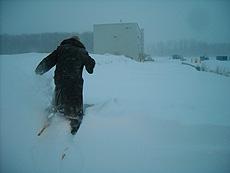Blizzard shows spirit of accelerator, detector crews
 |
|
AD's Chris Olsen uses snowshoes to make his way around the lab during the blizzard. Photo Courtesy of Darren Crawford.
|
Editor's note: This is the second article in a two-part series. The first article ran on Friday, Feb. 18.
Media and town officials said it was too dangerous to be outside; stay home, they said; enjoy a rare adult snow day. Schools closed, businesses closed, postal delivery ceased.
But operation of the Tevatron did not.
Amidst the worst blizzard in decades on Feb. 1-2, with nearly 15 inches of snow and more than 50 mph winds producing even higher drifts, the crews that keep Fermilab’s accelerators, detectors and cryogenic systems running showed up for work. They brought extra food and clothes, snow shoes and a determined attitude that bad weather would not best them.
Think of the accelerator operators as the Marine Corp. of science: they do the job when no one else wants to; they are the first line of defense. The accelerator complex never ever sleeps, even with the rest of the U.S. under a blanket of snow. Shutting it down would require lengthy, ramped up restart periods.
“You can’t just turn it off,” said Dan Johnson, head of the Accelerator Division’s Operations Department. “Even when the accelerators aren’t accelerating beam all the support systems have to run. The Tevatron has to stay cold, we still need vacuum, we still need water. If you’re not careful, the accelerator tunnel could flood."
“We just knew they were going to be here if they had to walk in with snow shoes on,” Johnson, said of the operators. “It presented a challenge and they love a challenge so they just handled it.”
And boy did they have challenges.
Some started work early to avoid getting trapped in unplowed roads and to prevent missing their midnight shifts; others stayed late to cover for employees who lived far away and couldn’t make it in. Some, such as Aron Soha at CDF and Darren Crawford in the Main Control Room, put in 15-to 18-hour shifts, catching brief respites of shut eye in out of the way rooms.
At 4 a.m. during the height of the blizzard with blowing snow nearly erasing the roadways, the Main Control Room got a call from the Meson Test Beam area from an experimenter who had struggled in from the village and said he was ready to take beam.
“That was a jaw dropper,” said Crawford, operator crew chief that night.
Read more
- Tona Kunz
|